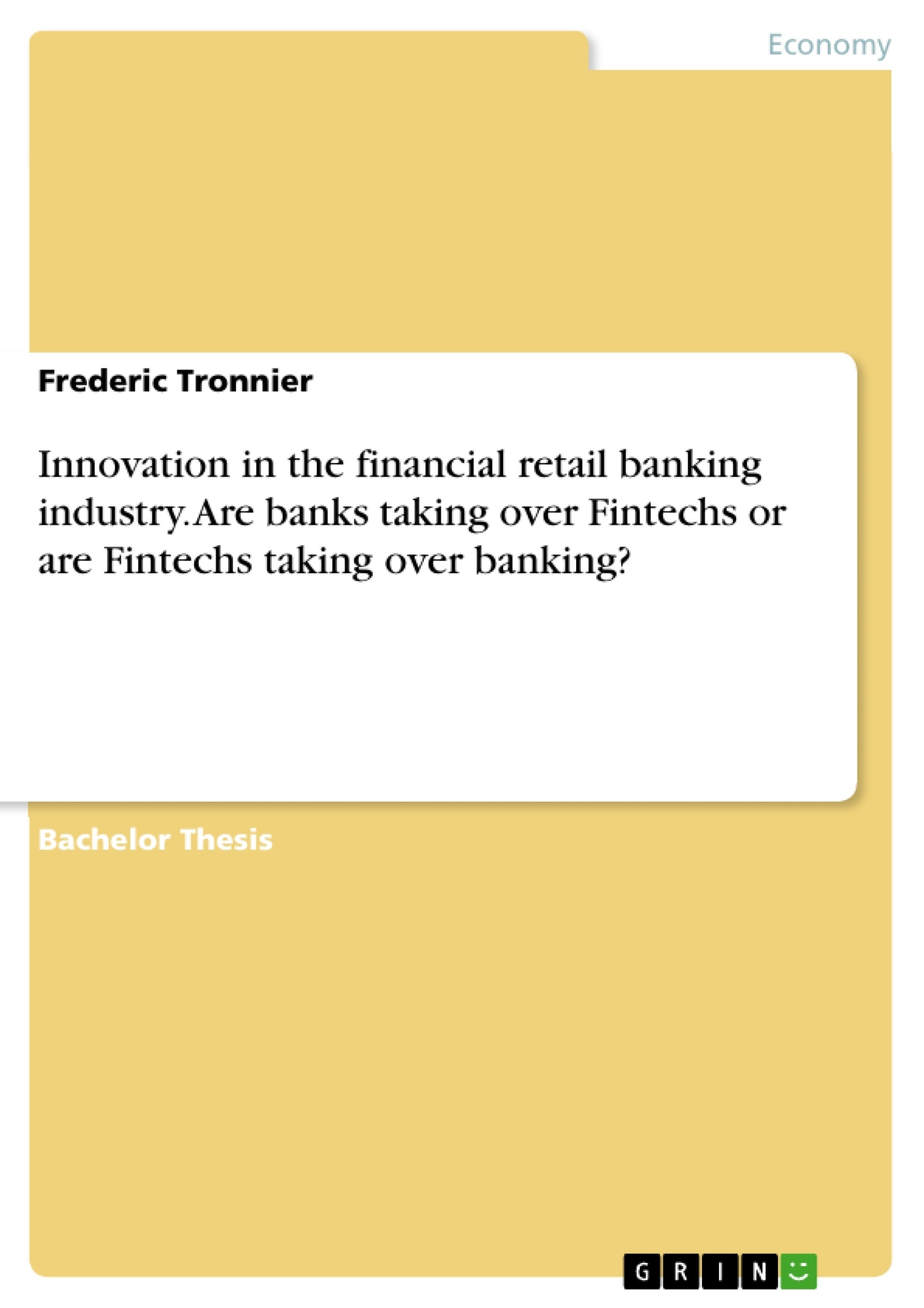The thesis focuses on how Fintechs are disrupting the financial retail banking industry and how banks react to these changes. In this context, challenges and opportunities of their actions will be analyzed and discussed.
Furthermore, it will be derived how aspects of innovation influence the Fintechs success in this process and how innovation takes place in the financial industry in general.
Finally, this thesis discusses the implications of the current situation for both Fintechs and banks, and identifies potential outcomes and consequences for all involved parties.
Since the beginning of the 21st century and the spread of the internet whole industries have been transformed or became obsolete.
Disruption in the form of digitalization has taken place in the music, book, media and movie industry. Online and mobile services, offered by start-ups and technology companies are changing one industry at a time. Retail-focused companies like Apple, Netflix, Google, Amazon and Twitter have changed the way people think and use music, films, books and media. They also changed the consumers’ general perception of good service, usability and of how companies are doing business.
Despite all these improvements in our everyday life, the financial retail banking industry has remained relatively constant, even though it caused people to adapt to new circumstances, in the form of the Global Financial Crisis (GFC), resulting in a Global Recession and higher regulations for the industry. Since then, the industry missed the opportunity to regain the customers’ trust by changing their habits and improving their services. Instead, customers are increasingly unlikely to buy products or refer their bank but are increasingly prepared to leave their bank within the next six months.
This state of stagnancy inside the financial retail banking industry seems to have changed. New entrants have caused uproar in the industry. Fintechs, an acronym for financial technology, are entering the retail market, forcing banks to adapt and innovate. Online and mobile banking services are now considered to be the future of financial retail banking. Fintechs threaten to take away customers by offering better and cheaper services with higher usability. As both the number of Fintechs and their customers increase, banks realize that Fintechs are going to be a threat for them.
Inhaltsverzeichnis (Table of Contents)
- Introduction
- A changing industry
- Purpose of this thesis
- Methodology
- Structure
- Innovation in the retail banking industry
- Innovation and change in customer behavior
- Trends in banking
- Fintechs
- General Information
- Business to Consumer (B2C) market
- Mobile Payment
- Lending
- Funding
- Personal Finance and Wealth Management
- Business to Business (B2B) market
- Software-as-a-Service (SaaS)
- Banks response strategies
- Copycat
- Collaborate
- Investment and Acquisition
- Internal Innovation
- Discussion
- Climax and shakeout
- Consequences for Fintechs
- Consequences for banks
- Consequences for the customer
- Recommendations
Zielsetzung und Themenschwerpunkte (Objectives and Key Themes)
This bachelor thesis explores the dynamic relationship between established banks and emerging Fintech companies in the retail banking industry. The thesis investigates the innovative forces driving change in customer behavior and the implications of Fintech advancements for both banks and customers.
- The impact of technological advancements on customer behavior and expectations in retail banking.
- The rise of Fintech companies and their disruptive potential in various areas of financial services, including mobile payments, lending, and wealth management.
- The strategies employed by banks to adapt to the Fintech challenge, including collaboration, investment, and internal innovation.
- The potential consequences of the Fintech revolution for both banks and customers, considering the evolving landscape of financial services.
- The potential impact of Fintech on the future of the retail banking industry, including the potential for consolidation and shakeout.
Zusammenfassung der Kapitel (Chapter Summaries)
The introduction establishes the context of a rapidly changing retail banking industry and defines the purpose and methodology of the thesis. Chapter 2 examines the drivers of innovation in the industry, including evolving customer behavior and emerging trends. Chapter 3 provides an overview of Fintech companies, focusing on their business models and activities in both the B2C and B2B markets. Chapter 4 analyzes the various response strategies employed by banks to address the Fintech challenge, including copycat strategies, collaboration, investment and acquisition, and internal innovation. The discussion chapter explores the potential climax and shakeout in the industry, analyzing the consequences for Fintechs, banks, and customers. The thesis concludes with recommendations for both banks and Fintech companies.
Schlüsselwörter (Keywords)
The thesis focuses on the intersection of financial technology (Fintech), retail banking, customer behavior, innovation, and competition. Key concepts include mobile payments, lending, wealth management, software-as-a-service (SaaS), bank response strategies, and the potential for industry shakeout.
- Citar trabajo
- Frederic Tronnier (Autor), 2016, Innovation in the financial retail banking industry. Are banks taking over Fintechs or are Fintechs taking over banking?, Múnich, GRIN Verlag, https://www.grin.com/document/334498
-

-

-

-
¡Carge sus propios textos! Gane dinero y un iPhone X. -

-
¡Carge sus propios textos! Gane dinero y un iPhone X. -

-
¡Carge sus propios textos! Gane dinero y un iPhone X. -

-
¡Carge sus propios textos! Gane dinero y un iPhone X. -

-
¡Carge sus propios textos! Gane dinero y un iPhone X. -

-
¡Carge sus propios textos! Gane dinero y un iPhone X. -

-
¡Carge sus propios textos! Gane dinero y un iPhone X. -

-
¡Carge sus propios textos! Gane dinero y un iPhone X. -

-
¡Carge sus propios textos! Gane dinero y un iPhone X. -

-
¡Carge sus propios textos! Gane dinero y un iPhone X. -

-
¡Carge sus propios textos! Gane dinero y un iPhone X.

